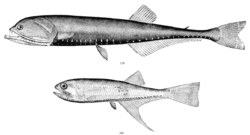Gonostomatidae
- "Bristlemouth" redirects here. This name is also used to refer to some of the related Sternoptychidae, namely the genus Argyripnus.
| Bristlemouths Temporal range: Miocene–Recent | |
|---|---|
 | |
| Elongated bristlemouth, Gonostoma elongatum (top) and Bonapartia pedaliota (bottom) | |
| Scientific classification | |
| Kingdom: | Animalia |
| Phylum: | Chordata |
| Class: | Actinopterygii |
| Order: | Stomiiformes |
| Family: | Gonostomatidae |
| Genera | |
|
Bonapartia | |
The Gonostomatidae are a family of deep-water marine fish, commonly named bristlemouths, lightfishes, or anglemouths. It is a relatively small family, containing only eight known genera and 32 species. However, bristlemouths make up for their lack of diversity with numbers: Cyclothone, with 12 species, is thought to be (along with Vinciguerria), the most abundant vertebrate genus in the world.
The fossil record of this family dates back to the Miocene epoch, and was discovered by L. S. Berg in 1958. The fish are mostly found in the Atlantic, Indian, and Pacific Oceans, although the species Cyclothone microdon may be found in Arctic waters. They have elongated bodies from 2 to 30 cm (0.79 to 11.81 in) in length.[1] They have a number of green or red light-producing photophores aligned along the undersides of their heads or bodies. Their chief common name, bristlemouth, comes from their odd, equally sized, and bristle-like teeth. They are typically black in color which provides camouflage from predators in deep, dark waters.
Taxonomy
Some classifications include the genera Pollichthys and Vinciguerria, but this article follows FishBase in placing them in the family Phosichthyidae.
Some classifications include species in the genus Zaphotias, but these are junior synonyms of the species Bonapartia pedaliota.
References
- Froese, Rainer, and Daniel Pauly, eds. (2012). "Gonostomatidae" in FishBase. February 2012 version.